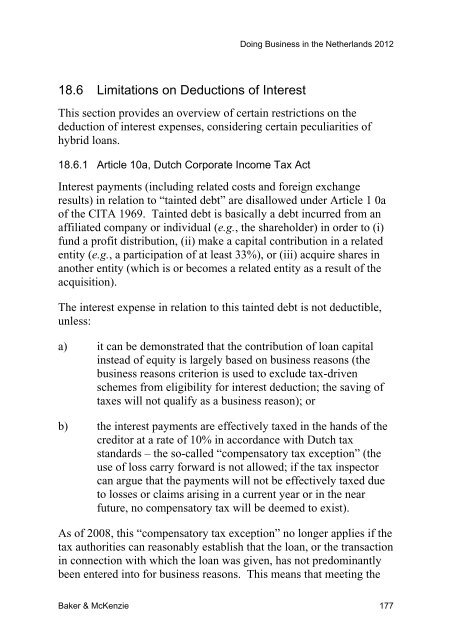Doing Business in the Netherlands 2012 - American Chamber of ...
Doing Business in the Netherlands 2012 - American Chamber of ...
Doing Business in the Netherlands 2012 - American Chamber of ...
You also want an ePaper? Increase the reach of your titles
YUMPU automatically turns print PDFs into web optimized ePapers that Google loves.
18.6 Limitations on Deductions <strong>of</strong> Interest<br />
<strong>Do<strong>in</strong>g</strong> <strong>Bus<strong>in</strong>ess</strong> <strong>in</strong> <strong>the</strong> Ne<strong>the</strong>rlands <strong>2012</strong><br />
This section provides an overview <strong>of</strong> certa<strong>in</strong> restrictions on <strong>the</strong><br />
deduction <strong>of</strong> <strong>in</strong>terest expenses, consider<strong>in</strong>g certa<strong>in</strong> peculiarities <strong>of</strong><br />
hybrid loans.<br />
18.6.1 Article 10a, Dutch Corporate Income Tax Act<br />
Interest payments (<strong>in</strong>clud<strong>in</strong>g related costs and foreign exchange<br />
results) <strong>in</strong> relation to “ta<strong>in</strong>ted debt” are disallowed under Article 1 0a<br />
<strong>of</strong> <strong>the</strong> CITA 1969. Ta<strong>in</strong>ted debt is basically a debt <strong>in</strong>curred from an<br />
affiliated company or <strong>in</strong>dividual (e.g., <strong>the</strong> shareholder) <strong>in</strong> order to (i)<br />
fund a pr<strong>of</strong>it distribution, (ii) make a capital contribution <strong>in</strong> a related<br />
entity (e.g., a participation <strong>of</strong> at least 33%), or (iii) acquire shares <strong>in</strong><br />
ano<strong>the</strong>r entity (which is or becomes a related entity as a result <strong>of</strong> <strong>the</strong><br />
acquisition).<br />
The <strong>in</strong>terest expense <strong>in</strong> relation to this ta<strong>in</strong>ted debt is not deductible,<br />
unless:<br />
a) it can be demonstrated that <strong>the</strong> contribution <strong>of</strong> loan capital<br />
<strong>in</strong>stead <strong>of</strong> equity is largely based on bus<strong>in</strong>ess reasons (<strong>the</strong><br />
bus<strong>in</strong>ess reasons criterion is used to exclude tax-driven<br />
schemes from eligibility for <strong>in</strong>terest deduction; <strong>the</strong> sav<strong>in</strong>g <strong>of</strong><br />
taxes will not qualify as a bus<strong>in</strong>ess reason); or<br />
b) <strong>the</strong> <strong>in</strong>terest payments are effectively taxed <strong>in</strong> <strong>the</strong> hands <strong>of</strong> <strong>the</strong><br />
creditor at a rate <strong>of</strong> 10% <strong>in</strong> accordance with Dutch tax<br />
standards – <strong>the</strong> so-called “compensatory tax exception” (<strong>the</strong><br />
use <strong>of</strong> loss carry forward is not allowed; if <strong>the</strong> tax <strong>in</strong>spector<br />
can argue that <strong>the</strong> payments will not be effectively taxed due<br />
to losses or claims aris<strong>in</strong>g <strong>in</strong> a current year or <strong>in</strong> <strong>the</strong> near<br />
future, no compensatory tax will be deemed to exist).<br />
As <strong>of</strong> 2008, this “compensatory tax exception” no longer applies if <strong>the</strong><br />
tax authorities can reasonably establish that <strong>the</strong> loan, or <strong>the</strong> transaction<br />
<strong>in</strong> connection with which <strong>the</strong> loan was given, has not predom<strong>in</strong>antly<br />
been entered <strong>in</strong>to for bus<strong>in</strong>ess reasons. This means that meet<strong>in</strong>g <strong>the</strong><br />
Baker & McKenzie 177





![912.025 AmCham News [1] - American Chamber of Commerce in ...](https://img.yumpu.com/9328612/1/190x127/912025-amcham-news-1-american-chamber-of-commerce-in-.jpg?quality=85)

